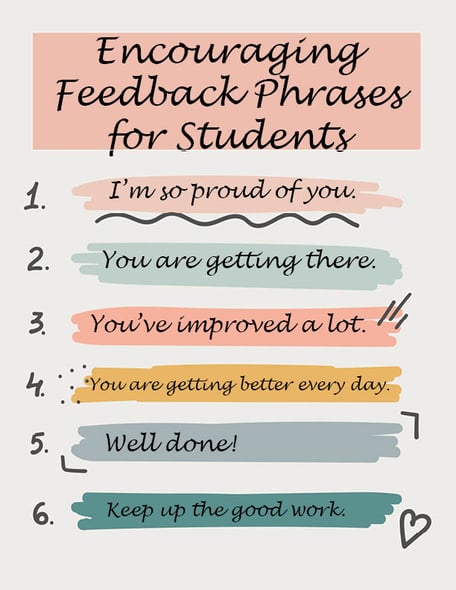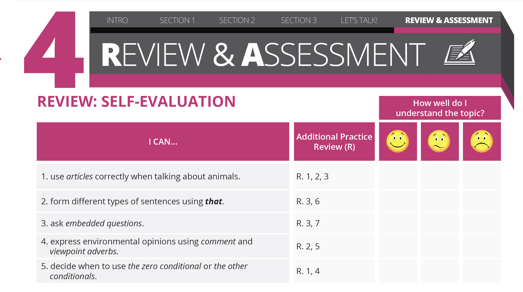Providing written & verbal feedback to students
No matter which subject and level you are teaching, providing meaningful, positive, and constructive feedback to your students is probably one of your most time-consuming daily tasks. As part of the grading process, you spend hours every week writing comments and notes to your students (and sometimes also their parents).
But, providing feedback to students does not have to be quite so complicated and labor-intensive. Here are some tips and tools to help save you time and energy.
Do's and Don'ts of providing feedback to students:
1. Provide verbal feedback whenever possible.
2. Use encouraging phrases when giving written feedback.
3. Let technology do (most of) the work for you.
4. Give feedback immediately after a learning moment.
5. Provide examples.
6. Follow the "feedback sandwich" rule (positive, constructive/negative, positive).
7. Keep your student's personality in mind.
8. Don't comment on everything all the time.
9. Provide feedback throughout the year.
10. Involve students in the feedback process.
1. Provide verbal feedback whenever possible.
Try to encourage and correct students during your lessons and time with them. It's easier to correct students and give them constructive criticism in person rather than in writing as intonation, tone of voice, and facial expressions help them better understand the feedback. Therefore, when teaching a language, verbal feedback should be the main "source" of feedback to give students a chance to hear the correct pronunciation, sentence structure, and words used in context.
Check out the SmartClass Teaching Platform for teaching languages as it gives you the option to provide verbal feedback for all of your students for every activity. Such a time saver and so important for students!
2. Use encouraging phrases when giving written feedback.

3. Let technology do (most of) of the work for you.
Ever heard of auto-graded activities? Until I used SmartClass I hadn't either. But these textbooks in German, Spanish, and English come with over 50% auto-graded activities and automatically corrected pronunciation practice. I used the time I saved by not having to grade easy assignments to correct and focus on speaking activities my students submitted. And, as mentioned before, you can give verbal feedback for every single activity, which saved me a ton of time typing out comments.
4. Give feedback immediately after a learning moment
Don't wait until the next report card or progress report to give your students feedback. I'd personally not even wait an entire day if it was something I noticed during a lesson. Immediate feedback, rather than allowing time to pass, is better remembered and helps the learning process.
5. Provide examples
Heard your student say something he got wrong before? Make sure to mention that! Providing examples of HOW your students have improved will help them see that their hard work is paying off. Same when they make a mistake: Correct them and give them another example of what to say or write next time and in a different situation to help them understand.
6. Follow the "feedback sandwich" rule (positive, constructive/negative, positive)

When giving longer feedback or writing comments on report cards, start out by saying something positive, followed by criticism and constructive feedback. Then, end with another positive comment. That way, you ensure your students don't only get negative feedback, and packing the negative feedback between two positive "slices" will soften it a bit.
7. Keep your student's personality in mind
Some students might do better with and appreciate criticism, while others get discouraged and sad when they make a mistake. Always keep in mind who you are talking or writing to and try to think of the feedback so they stay motivated and continue to be excited to learn.
8. Don't comment on everything all the time
There is a time and place for feedback, and it's not easy to find the right timing. Try not to over-comment on someone's mistakes, even when they repeatedly make them. It's also helpful to pull students aside to give them feedback so not everyone else in the class hears. Or, try to generalize feedback to the entire class about something most of your students do wrong. Then no one feels singled out, and it makes students feel better knowing that everyone is struggling with something.
The same goes for praise. Always calling on the one or two students that get everything right can be discouraging for the rest of the class. Make sure you find a way to incorporate that in written or individual verbal comments to those students and find a way to make everyone stand out as a good example sometimes.
9. Provide feedback throughout the year
Students can't learn if they don't know what they are doing wrong. Making mistakes is totally normal and should be presented as an opportunity rather than a flaw. Make sure you start giving positive and negative feedback throughout the school year, and not only on report cards or during finals.
10. Involve students in the feedback process.

Self-evaluations are a great way to involve students in their learning process and make them responsible for their own progress. The CEFR offers Can-Do statements for each level and skill so students and teachers alike can review the learning progress.
The "Let's Talk! English" curriculum from Robotel already offers such self-assessment rubrics, but you can also create those based on your lessons and goals.



